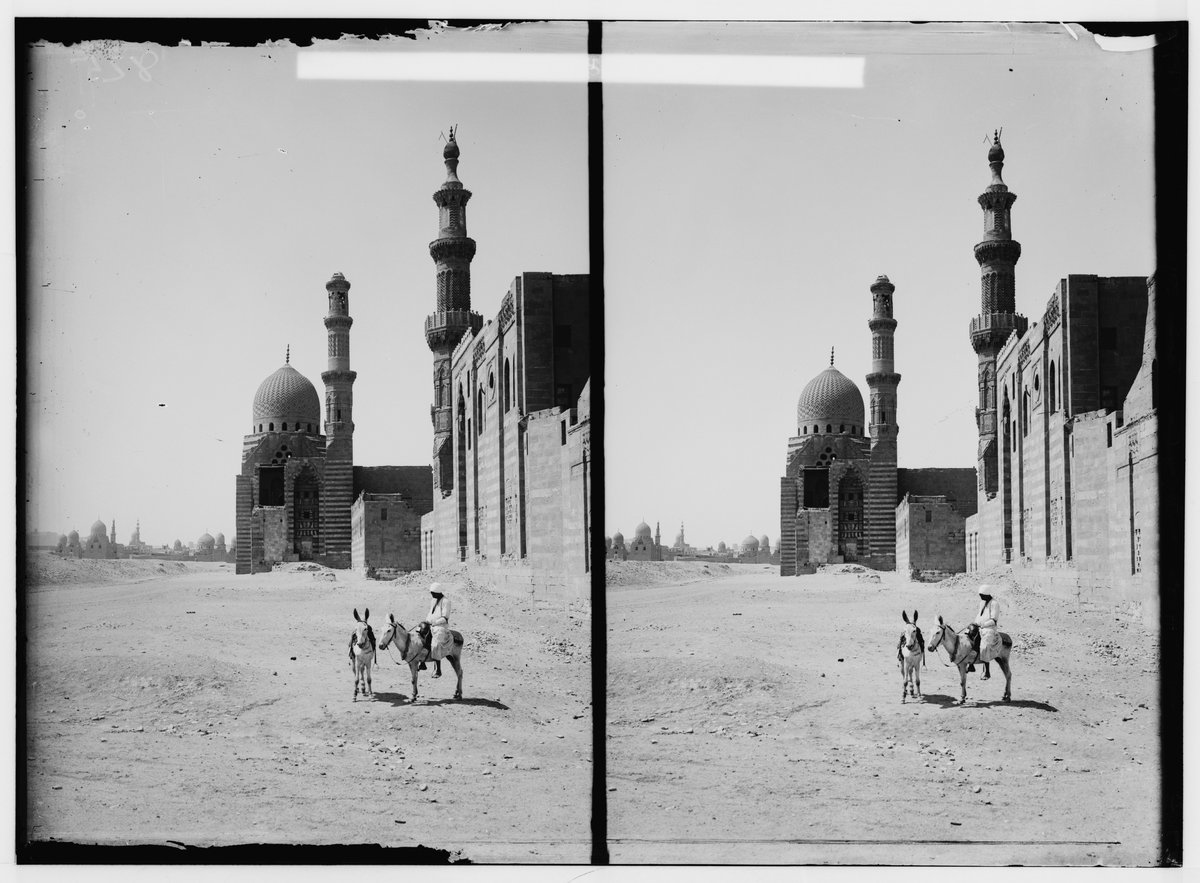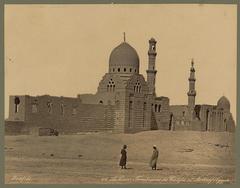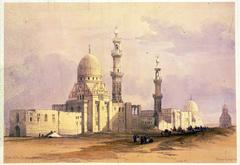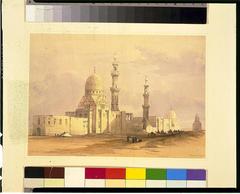
Emir Qurqumas Complex: Visiting Hours, Tickets, and Historical Significance in Cairo, Egypt
Date: 14/06/2025
Introduction
The Emir Qurqumas Complex, nestled within Cairo’s iconic Northern Cemetery—familiarly known as the “City of the Dead”—is a masterpiece of late Mamluk architecture and a vibrant symbol of Egypt’s rich historical and cultural legacy. Built between 1506 and 1507 CE by Emir Qurqumas, a prominent Mamluk commander, this complex seamlessly combines a mosque-madrasa, domed mausoleum, khanqah (Sufi lodge), sabil-kuttab (public fountain and Qur’an school), and residential quarters. Today, it stands as a testament to the ingenuity of Mamluk artisans and the enduring spiritual and social values of the era (Wikipedia; PCMA).
This guide offers a comprehensive overview of the Emir Qurqumas Complex, detailing its historical background, architectural significance, cultural roles, conservation status, practical visitor information, and tips for exploring nearby attractions.
Table of Contents
- Introduction
- Historical Background and Context
- Architectural and Artistic Features
- Social, Religious, and Cultural Roles
- Conservation and Archaeological Research
- Visiting Information
- Visuals and Media
- Frequently Asked Questions (FAQ)
- Conclusion and Call to Action
- References
Historical Background and Context
The Mamluk Era and Emir Qurqumas
The Mamluk Sultanate (1250–1517) was a period of great military, architectural, and cultural achievement in Egypt. Emir Qurqumas, originally a mamluk (slave-soldier) under Sultan Qaitbey, rose to the rank of Grand Amir and Commander of the Armies under Sultan Qansuh al-Ghuri. His leadership coincided with the twilight of the Mamluk regime, just before the Ottoman conquest in 1517. Qurqumas was revered for his generosity and modesty, with chronicler Ibn Iyas noting widespread mourning at his funeral, in which Sultan al-Ghuri himself participated (Wikipedia; PCMA).
Architectural Style and Design Influences
Constructed in 1506–1507 CE, the complex embodies the refined style of Sultan Qaitbey’s era, favoring intricate ablaq masonry, monumental portals, and harmonious proportions. Its design integrates multiple functions—religious, educational, social, and charitable—distinguishing it as a model of Mamluk urbanism and patronage (Archnet; Victoria and Albert Museum).
Architectural and Artistic Features
Layout and Context
The Emir Qurqumas Complex stretches along a 170-meter façade, forming a monumental axis in the Northern Cemetery alongside the Sultan Inal Complex. Its components include:
- Mosque-Madrasa: A cruciform layout with a minaret and sabil-kuttab, serving as both a place of worship and learning.
- Domed Mausoleum: Finely decorated with arabesque stonework, muqarnas, and Quranic inscriptions, symbolizing spiritual ascent.
- Khanqah (Sufi Lodge): Provided space for Sufi worship and communal living, a key aspect of Mamluk spirituality.
- Residential Quarters: Housed Qurqumas’s family and Sufis, reflecting the complex’s social and charitable functions.
Artistic Innovations
- Entrance Portal: Noted for its ablaq masonry, monumental arch, muqarnas hood, carved arabesques, geometric patterns, and thuluth script (Victoria and Albert Museum).
- Interior Elements: Includes a richly inlaid mihrab, intricate wooden minbar, colored glass windows, and a luminous dome. The interplay of light and shadow creates a serene, spiritual atmosphere.
- Decorative Arts: Employs polychrome marble, carved stucco, mosaic flooring, and ornate woodwork, showcasing the cosmopolitan artistry of Mamluk Cairo.
Social, Religious, and Cultural Roles
The Emir Qurqumas Complex was more than a funerary site; it was a center of education, spirituality, and public welfare.
- Mosque-Madrasa: Facilitated daily prayers and advanced religious studies.
- Khanqah: Hosted Sufi dervishes and spiritual gatherings, underscoring the importance of Sufism in Mamluk society.
- Sabil-Kuttab: Provided free water and education, reflecting the era’s commitment to charity and public service.
- Charitable Endowments (Waqf): Funded ongoing maintenance, staff salaries, and community services, ensuring the complex’s sustainability (PCMA; Wikipedia).
The complex’s integration within the City of the Dead, where families and communities live among the tombs, highlights the coexistence of life, death, and spirituality—an enduring feature of Cairo’s unique urban fabric (Egyptian Streets).
Conservation and Archaeological Research
Centuries of neglect, environmental challenges, and urban encroachment took a toll on the complex. Major restoration campaigns—most notably the Polish-Egyptian program (1972–2000)—have stabilized the structures, restored delicate decorative elements, and documented the site’s architectural features (Archnet; Veronika’s Adventure). Archaeological research has uncovered waqf documents, original wooden ceilings, and artifacts illuminating everyday life in Mamluk Cairo.
As part of the UNESCO World Heritage “Historic Cairo,” the complex now benefits from international attention and ongoing conservation efforts, balancing heritage protection with community needs (Veronika’s Adventure).
Visiting Information
Hours and Tickets
- Opening Hours: Daily, 9:00 AM to 5:00 PM (closed Fridays and public holidays; check locally for seasonal changes).
- Tickets: Approximately 50–60 Egyptian Pounds for adults; discounts for students, children, and seniors. Tickets are available on-site; online booking is not yet standard.
- Entry: Admission may also be included in broader tickets for the City of the Dead’s monuments.
Accessibility
Some areas are challenging for those with mobility impairments due to historic surfaces and steps, but ramps have been installed at key entrances. Contact the site office in advance for assistance.
Guided Tours
Guided tours are available and highly recommended, providing context on the site’s architecture, history, and religious functions. Book on-site or through local tour operators.
Nearby Attractions and Travel Tips
- Sultan Inal Complex: Adjacent Mamluk monument with similar architectural significance.
- Sultan Qaytbay Mosque: Another masterpiece of Mamluk funerary art nearby.
- Khan el-Khalili Bazaar: Historic market district perfect for combining cultural exploration.
- Tips: Wear comfortable shoes, bring water and sun protection, and visit early to avoid crowds and heat.
Visuals and Media
- Images: Domed mausoleum, entrance portal with ablaq masonry, mosque-madrasa interiors, and sabil-kuttab.
- Alt Text Example: “Domed mausoleum of Emir Qurqumas in Cairo’s City of the Dead.”
- Virtual Tours: Explore high-quality photos and virtual walkthroughs via Archnet and Victoria and Albert Museum.
Frequently Asked Questions (FAQ)
Q: What are the visiting hours?
A: Daily from 9:00 AM to 5:00 PM (except Fridays and public holidays; check ahead for updates).
Q: Are there entrance fees?
A: Yes, typically 50–60 EGP for adults, with discounts for students, children, and seniors.
Q: Is the complex accessible for visitors with disabilities?
A: Some improvements exist, but parts remain challenging; contact ahead for assistance.
Q: Can I take photographs?
A: Photography is generally permitted; respect signs and the sanctity of the site.
Q: Are guided tours available?
A: Yes, book at the entrance or via local tour operators.
Q: What other attractions are nearby?
A: Sultan Inal Complex, Sultan Qaytbay Mosque, and Khan el-Khalili bazaar.
Conclusion and Call to Action
The Emir Qurqumas Complex is a living symbol of Cairo’s Mamluk heritage, blending architectural mastery, spiritual devotion, and social responsibility. Conservation and research efforts have preserved its splendor for future generations. Whether you’re a history buff, architecture lover, or curious traveler, this site offers a profound connection to Egypt’s layered past.
Plan your visit to the Emir Qurqumas Complex and discover a unique intersection of faith, artistry, and community. For more information, download the Audiala app, follow our social media channels, and explore related guides to Cairo’s historic sites.
References
- Emir Qurqumas complex, Wikipedia
- Cairo Complex of Emir Qurqumas, Polish Centre of Mediterranean Archaeology
- Emir Qurqumas Funerary Complex, Egyptian Streets
- Emir Qurqumas Complex, Archnet
- Entrance Portal of the Funerary Complex of Emir Qurqumas, Victoria and Albert Museum
- Historical Religious Complex in Cairo, Veronika’s Adventure
- The Religious Complex in Egypt, King of Egypt Tours
- Audiala




































